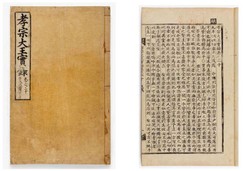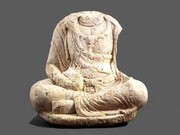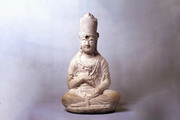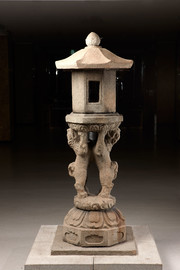After a long-term effort, the Mount Odae Edition of the Annals of the Joseon Dynasty and Uigwe were able to return to their original place. On February 14th, the resolution for returning the Mount Odae Edition of the Annals of the Joseon Dynasty and Uigwe to their own place passed the plenary session of the National Assembly. This result came from the hard work of many people including Buddhists and Gangwon-do residents, and they are delighted with the announcement. The Mount Odae Edition of the Annals of the Joseon Dynasty and Uigwe are cultural assets of Korea that were stolen by the Japanese during the Japanese colonial period and were brought back to Korea in 2006 and 2011, respectively. They were kept at the National Palace Museum of Korea in Seoul without being able to return to their original location in Pyeongchang. After this decision, monk Jeongnyeom of Woljeongsa Temple of Mount Odae in Pyeongchang, who had put a lot of effort into having the Annals of the Joseon Dynasty and Uigwe returned to Pyeongchang, said, “In the meantime, the restitution committee, Buddhists, and members of the National Assembly have worked together and made their return to our original place.” If so, what kind of process did it take to find their own place? Also, what are the remaining challenges? Let's learn more about this.
Mount Odae Edition of the Annals of the Joseon Dynasty and Uigwe’s History

『The Annals of the Joseon Dynasty』 is a book that recorded the history of the 25 generations (1392~1863) from the reign of King Taejo to King Cheoljong in a chronological format[1]. The Annals of the Joseon Dynasty is internationally recognized for its objectivity and reliability and was registered as a UNESCO World Heritage Artifact in 1997. In the past, multiple sets of the Annals of the Joseon Dynasty were divided and kept in several places for several reasons such as preventing complete loss in the event of a fire. In 1592, the Japanese Invasion of Korea broke out and all the annals, except for the Jeonju edition, were lost. Based on the remaining annals of Jeonju, the four annals from the reign of King Taejo to King Myeongjong were republished. However, due to economic difficulties after the war, only 3 of the 4 copies were printed as officially certified copies, and one copy was made by collecting proofreads that corrected type errors. The history archive in Mount Odae in Pyeongchang, Gangwon-do was established around 1606, and the proof copies from the reign of King Taejo to King Myeongjong, the officially certified copies from the reign of King Seonjo to King Cheoljong were stored there. In this way, a total of 788 volumes were stored at Mount Odae. Then, in 1910, the Japanese colonial period began, and the Annals of the Joseon Dynasty, which were kept in Mount Odae, were taken by the Japanese with the intention of donating them to the Tokyo Imperial University’s library around 1913. However, in 1923, when the Great Kanto Earthquake occurred in Japan, most of the Annals were lost due to a fire. Among the Annals of Mount Odae, which avoided destruction by fire, 27 volumes were transferred to Keijo Imperial University in 1932. After independence, they were transferred to Seoul National University's Kyujanggak. In 1973, the remaining 27 volumes were designated as National Treasure No. 151. Also, in 2006, 47 volumes that avoided the fire but were left in Japan, were donated by Tokyo Imperial University to Kyujanggak and were included in National Treasure No. 151-3. In 2018, one additional annal that was missing was returned, and a total of 75 volumes are currently in the collection of the National Palace Museum of Korea.

Meanwhile, the Uigwe is a record of the main events of the royal family and the state during the Joseon Dynasty. It was registered as a UNESCO World Heritage Artifact in 2007, in recognition of its rarity. It allows a visual understanding of life in the Joseon Dynasty by depicting the clothes worn by the king at events such as weddings and banquets and the arrangement of processions. The Uigwe of the Joseon Dynasty was produced from the beginning of the Joseon Dynasty, but it was all destroyed during the Japanese Invasion of Korea in 1592 and was produced again in earnest from the middle of the Joseon Dynasty. The multiple sets of Uigwe were stored separately in related government offices and at local history archives such as the one in Mount Odae. However, in 1910, the Japanese colonial period began, and in 1922, 72 volumes that were stored in the Mount Odae were taken to Japan in the form of a donation to the Japanese royal family by the Japanese Government-General of Korea. Afterward, in the process of returning the Annals of the Joseon Dynasty from Japan in 2006, while investigating the whereabouts of the main documents stored in the Mount Odae, the volumes of Uigwe were found to be in the Imperial Household Agency of Japan. In response, Buddhists and others sent a request for return to the Japanese embassy in 2006. After several efforts, they were returned to the National Palace Museum of Korea in December 2011.
Movements for Redemption
The National Palace Museum of Korea, which currently houses the Mount Odae Edition of the Annals of the Joseon Dynasty and Uigwe, is located in Jongno-gu, Seoul. Over a long period of time, the Annals of the Joseon Dynasty and Uigwe were returned to Korea, but they did not return to their original location in Pyeongchang. Accordingly, Pyeongchang Mount Odae Woljeongsa Temple, Buddhists, Gangwon-do residents, and private organizations have been campaigning since 2006 so the Mount Odae Edition of the Annals of the Joseon Dynasty and Uigwe could be kept in their original locations. On December 16th, 2011, Choi Doo-young, former governor of Gangwon-do, pointed out that “Enshrining the Mount Odae Edition Uigwe at Mount Odae means finding the absolute value of our cultural heritage.” However, the Cultural Heritage Administration rejected their request for return on the grounds that there was no facility to store the Annals and Uigwe at Mount Odae. Then, in July 2012, the Cultural Heritage Administration designated the National Palace Museum of Korea as the managing body of the Annals and Uigwe. Accordingly, Woljeongsa established the Wangjo Sillok Uigwe Museum at Mount Odae in Pyeongchang in November 2019 to store the Annals and Uigwe. Approximately 13.1 billion won was invested to establish the museum, by the Ministry of Culture, Sports and Tourism, local governments, and Woljeongsa Temple. The museum is 3,500 square meters in size and was established as a state-of-the-art facility equipped with incense and dehumidifying devices as well as a security system. It was expected that the Annals and Uigwe would be restored to their original positions as the government budget was also allocated to this. However, the Cultural Heritage Administration postponed their return and only sent photoprints. The stance of the Cultural Heritage Administration was that the “national management principle” of the preservation and management of state-owned cultural properties should be observed. In the end, on June 16th, 2021, Woljeongsa, the culture and arts community, civic groups, and Gangwon-do residents launched a redemption committee. At that time, monk Jeongnyeom, co-chairman of the redemption committee, expressed his will, saying, “We will gather the passion and the hearts of the people as one so that this plundered cultural property will be returned and the way to Mount Odae will be opened.” In June 2021, according to the Beopbo News, the chief monk of Woljeongsa Temple, said, “Cultural assets show their true value in their original location. […] If the Mount Odae Edition stays out of place, its value will inevitably fade.”
Establishment and Operation of the Exhibition Hall

In the end, the Cultural Heritage Administration partially accepted the request of the redemption committee. On February 14th, the resolution for returning the Mount Odae Edition of the Annals of the Joseon Dynasty and Uigwe to their own place passed the plenary session of the National Assembly. In the resolution, “Mount Odae Edition of the Annals of the Joseon Dynasty and Uigwe were returned (from Japan) after the redemption campaign centered on Woljeongsa Temple, and the original site, Mount Odae, has sufficient capacity and preparations to manage them. […] Many people who visit Mount Odae should be able to view the Annals and Uigwe and engrave their meaning and value. The returned Annals and Uigwe will be shared with the people as a legacy that vividly remembers history, looks at the present, and paints the future.” The resolution reflects the position of the Cultural Heritage Administration's principles for the state management of state-owned cultural assets. The position of the redemption committee, which aspires for the return of the Annals and Uigwe to their original place is also reflected at the same time. It is to establish and operate an exhibition hall as a national institution so that the Annals and Uigwe can be returned to their original places. Woljeongsa, the founder of the Wangjo Sillok Uigwe Museum, established in 2019, will donate it to the state. After, the museum will be converted into a national institution. If the Wangjo Sillok Uigwe Museum is converted into a national institution, both the Annals of the Joseon Dynasty and Uigwe from the Mount Odae can return within 2022. In conclusion, the Mount Odae Edition of the Annals of the Joseon Dynasty and Uigwe were able to return to Pyeongchang, and the exhibition hall will be operated by the government. Through this resolution, while respecting the responsibility and obligation of the government for the preservation and management of state-owned cultural properties, the historicity of cultural properties has been restored.
The Remaining Assignments
Changes in the Perspective of the Government
Some point out that the government needs a change of perspective. With the revision of the Local Autonomy Act and the implementation of the self-governing police system, awareness of autonomy and decentralization has been strengthened. Korea is also entering the era of autonomy and decentralization. However, it is said that this decision, in which the Cultural Heritage Administration decided only to stick with the principle of national management in state-owned cultural heritage and eventually convert the museum into a national institution, does not reflect the times. The Cultural Heritage Administration opposed the local management of the Annals and Uigwe and adhered to state management. In this regard, it is also pointed out that refusal to recognize local governments and private organizations despite the maturity of their ability and conditions to preserve and utilize cultural assets is “against decentralization and cultural decentralization.” Monk Jeongnyeom also expressed his disappointment, saying, “Although it is possible to decentralize local cultural assets to use them as tourism resources and make them a local icon, the government is unable to come up with such a policy.” Also, many are pointing out that there are organizational and financial limitations for the state to establish a national exhibition hall to manage cultural assets directly when similar events like the restoration of the Annals and Uigwe occur. Eventually, people argue that the policy of the Cultural Heritage Administration needs to bring a change of point of view since they are negative towards local public opinion.
Other Cultural Properties That Have to Be Returned
There are many cultural assets that are still awaiting restoration in addition to the Annals of the Joseon Dynasty and Uigwe. One of them is “Manjurshri Riding a Lion” from Hansongsa Temple. It consists of two pairs. It was originally located in Gangneung but was illegally exported by the Japanese in 1912. Then, in 1965, as a result of the Korean-Japanese Conference, it was returned to Korea, and National Treasure No. 124 was stored in the Chuncheon National Museum while Treasure No. 81 (the piece completing a set with National Treasure No. 124) was stored in Gangneung Ojukheon & Municipal Museum. Accordingly, there is an active movement to return National Treasure No. 124 stored in the National Chuncheon Museum to its original location in Gangneung. On January 30th, the social and cultural committee of the Gangwon Provincial Council adopted the proposal for restoring Manjurshri Riding a Lion from Hansongsa Temple. The proposal said, “It is meaningful when two stone statues that support both sides of the central main Buddha and form a symmetrical shape are stored in one place.” Meanwhile, National Treasure No. 103 “Twin Lion Stone Lantern of Jungheungsanseong Fortress, Gwangyang” was originally located in Gwangyang, but after many attempts, it has been moved to the Gwangju National Museum. On February 9th, Rep. Kim Gil-yong (Gwangyang 3, Democratic Party of Korea) said, “The Cultural Heritage Administration and the Ministry of Culture, Sports, and Tourism should return the stone lantern. It should support the budget for cultural policies and projects that local governments lead in accordance with the era of decentralization.”

https://bit.ly/3tG2S91

https://bit.ly/3MxL3Sh

https://bit.ly/3tEBWqd
The Mount Odae Edition of the Annals of the Joseon Dynasty and the Uigwe can be returned to their original places after a long period of history. However, there are still tasks remaining. In the process of restoring them, the government's stance of adhering to the state management principles of state-owned cultural properties has not changed. Now that we are entering the era of autonomy and decentralization, the attitude of sticking to only principles does not fit with the times and becomes a big obstacle to the decentralization of local culture. Also, there are many other cultural assets waiting for their return. The government should make efforts to help the remaining cultural assets find their proper places. It is also necessary to consider strengthening local cultural decentralization by acknowledging the ability of local governments to preserve and utilize cultural heritage. CAH hopes that the remaining cultural assets will succeed in their return home in the best way.
[1]One of the methods of historical narrative, in which historical facts are recorded in the order in which they occurred.

